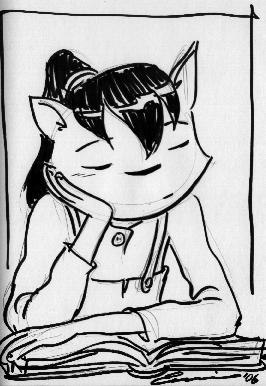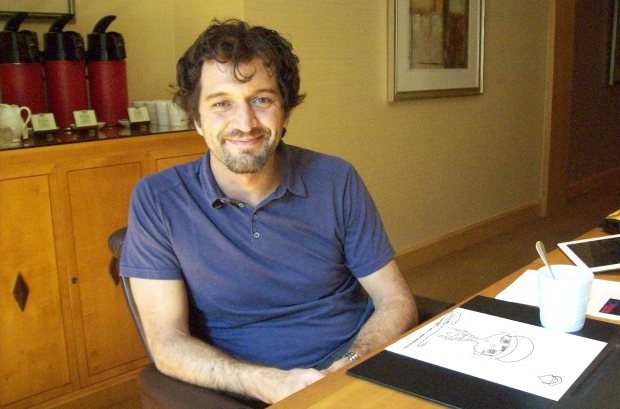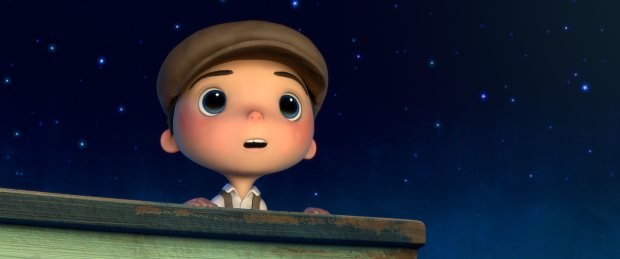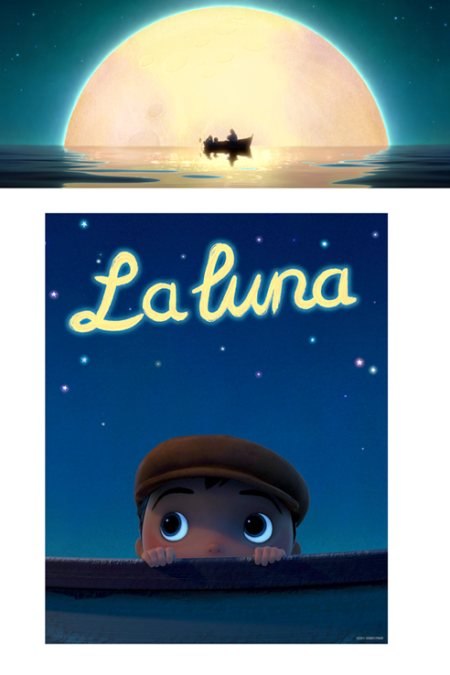The year-plus early teaser trailer is a given for spectacular genre movies nowadays… but how about the full release of an entire movie – an animated Pixar film at that – some ten months before its official premiere? In this case however, the Pixar film in question runs all of seven minutes and is set to accompany the summer 2012 release of Brave, Pixar’s next full-length feature. It’s called La Luna, and it’s the story of a boy, his dad, granddad… and their peculiar relationship with the celestial body of the title.
The year-plus early teaser trailer is a given for spectacular genre movies nowadays… but how about the full release of an entire movie – an animated Pixar film at that – some ten months before its official premiere?
In this case however, the Pixar film in question runs all of seven minutes and is set to accompany the summer 2012 release of Brave, Pixar’s next full-length feature. It’s called La Luna, and it’s the story of a boy, his dad, granddad… and their peculiar relationship with the celestial body of the title.
So why the head start? Turns out Pixar has its sights set on taking home the Best Animated Short Oscar in 2012, which meant La Luna had to hit the screen this year. One three-day, now-you-see-it, now-you-don’t run at an L.A. theater later, and voila, La Luna is an official contender for the gold. If things work out the way the Disney folks hope, next summer’s Brave ads will include something along the lines of “plus the Oscar®-winning short La Luna!”
If its title isn’t a dead giveaway (or its characters’ Italian-tinted cartoon gibberish and body language), the film is the creation of Genoa-born Enrico Casarosa, a Pixar story artist enjoying his first directorial credit. “I found a good story to tell, a personal one and I wanted to give it a flavor of part of what I am.
“Our grandfather lived in our house and never quite got along [with our father]. This little boy stuck between these big personalities – that was definitely me. That seemed like a good core for a story: a little boy finding his own way and learning to trust his instincts.”
While some look at the Pixar shorts as a training round for future Pixar directors, it ain’t necessarily so: to date only Geri’s Game director Jan Pinkava went onto a feature credit, co-directing Ratatouille with Brad Bird. What it is, however is an all but guaranteed lock on an Oscar nomination: from 1997 through 2008, every short accompanying a Pixar feature has been nominated for an Oscar, with two of them (Geri’s Game and For the Birds) bringing home the gold. (And if you jump back a decade you can add an extra trophy for 1988’s Tin Toy.)
If there was a lot of competition for a chance to pitch a short, Casarosa wasn’t aware of it. “I wasn’t terribly aware how many people were pitching at the time. You work with Development and find a date, and just the fact that you’re heard and be able to pitch – hey, that’s more than enough. So I took it step by step. I really felt like it was worth doing. [If Pixar passes on the project] I’ll do a kids book, or I’ll do my own thing with it.”
La Luna’s closing credits appear atop watercolor and pencil drawings that were originally part of Casarosa’s ‘beat boards.’ “That’s the way I pitched the idea to begin with, with 20-30 images to tell the whole story. That’s a wonderful way to see the shape of it. I love to work that way, you kind of write visually to begin with. They gave us something to aim for artistically, to try to bring some of the look of that traditional media into the CG.
“When we pitched La Luna to John [Lasseter] he really loved it. He’s very much involved with the shorts as executive producer of them, the person who says ‘I like this, go ahead and start storyboarding, developing it.’ You’re like ‘ohmigod, this is gonna happen.’”
Pixar’s creations have been described as existing in the zone between commerce and art, and as Casarosa sees it, “the shorts have this wonderful opportunity to be closer to the art side. They don’t need to go out and make millions” as do the features.
The cartoon bug first bit Casarosa as a child in Genoa, watching Italian-dubbed episodes of Hayao Miyazaki’s Lupin III TV series. An animation education at New York’s School of Visual Arts led to design work on the 101 Dalmatians and PB&J Otter TV series. And while convincing Pixar to hire you might seem a daunting task, Casarosa says the real challenge was making the jump from TV animation into features, a leap that landed him at Blue Sky Studios. “I tried once and didn’t get in. I tried again and they said ‘you only have TV experience – can you do a test for us?’ I boarded an idea that they liked and I finally got in. I worked on the first Ice Age for two years.”
His Ice Age credentials probably didn’t hurt, but it was a side project that helped Casarosa scale the iron gates in front of Pixar’s Emeryville California studios: a comic book about a flying feline…

“When you make these side projects you never think about your own main career but it actually helps you more than whatever you put in a portfolio. The comics came mostly out of working in little studios here in New York and people being frustrated with their day jobs. You have to channel that frustration so we made comics anthologies. I came up with ‘Adventures of Mia,’ about a little flying girl Strangely enough Mia is M-I-A – missing in action, because I haven’t done it for so many years now.”
(Mia’s not entirely MIA; you can see her on Casarosa’s website at enricocasarosa.com/mia.html. One reviewer who found himself enthralled by Mia enthused “Casarosa is a master of visual storytelling, and of setting the tone with visuals alone” – praise that applies equally well to La Luna.)
“Ronnie Del Carmen is a very good friend; we met when we were making comics. He was the one who said ‘why don’t you submit your work?’ [to Pixar]. After I did that I went in to meet with a few people. After two or three months they offered me a job.
“I was the first story artist on Ratatouille, worked on it for four years. It was not an easy production – it went through a lot of changes, but I embraced it with its difficulties and all. By the time Brad Bird came around I was pretty burnt out. I was there for another six months, then I moved onto Up, which I was thankful for.”
Now that he’s successfully directed a short for the studio does Casarosa have any plans to pitch a feature? “Right now I’m busy helping Bob Peterson who’s directing the new 2013 movie with Pete Sohn. They announced it at D23 [the studio’s official fan club]. We don’t have a title yet – right now we’re calling it the ‘dinosaur project.’ [Pixar’s official blog asks “what if that life-changing asteroid missed Earth? Director Bob Peterson’s hilarious tale depicts a world where dinosaurs never went extinct.”] I’m kind of helping them as head of story, so that might keep me busy for a while.
“But you know someday I would love to pitch something. In the meanwhile I’ll percolate a little bit.”










